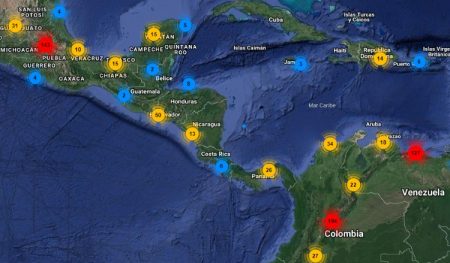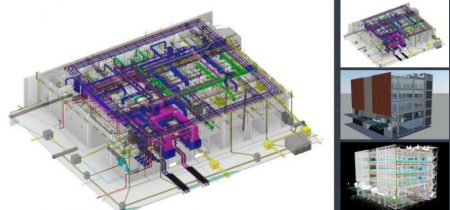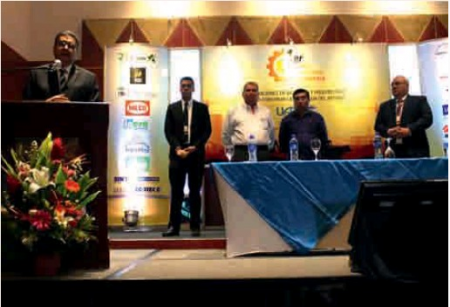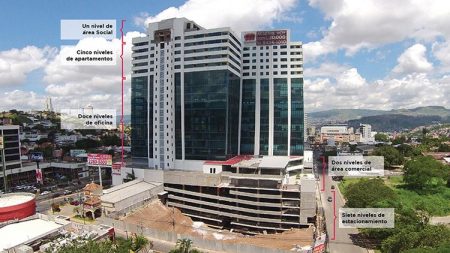Advancement and implementation of BIM - Central America case
Having been to the BIMSummit in Barcelona last week has been exciting. See how different perspectives, from the skeptical to the most visionary, agree that we are in a special moment of the revolution in industries that range from the capture of information in the field to the integration of operations in the citizen's real time. BIM plays a very important role in that convergence of the energy of technological inventiveness that is used by the business sector, the demand for better services from the end user of public services and the balance that standardization can exert.
 But between the optimistic success stories of the Nordic countries where talking about OpenSource no longer offends anyone's private interests, and the urgency of the technological vanguard countries where the agenda is developed by the private sector, there is the pragmatic reality of the countries where the inefficient performance of the State due to its regulatory role in search of better scenarios in the country. In this case, we talk a bit about my last conversation with Gab !, a Geofumadas collaborator who, in half an hour of coffee, told me about her vision of BIM in the Central American context.
But between the optimistic success stories of the Nordic countries where talking about OpenSource no longer offends anyone's private interests, and the urgency of the technological vanguard countries where the agenda is developed by the private sector, there is the pragmatic reality of the countries where the inefficient performance of the State due to its regulatory role in search of better scenarios in the country. In this case, we talk a bit about my last conversation with Gab !, a Geofumadas collaborator who, in half an hour of coffee, told me about her vision of BIM in the Central American context.
Realistically, the best breakthrough experiences in this context may be hidden by limited systematic visibility; so we have to resort to what we have heard there. From the outset, there is a greater dissemination of progress in countries such as Costa Rica and Panama, however, in the other countries of the region, although there is knowledge at private levels, the academic and state context is hardly visible at the implementation level; If we see it from the broad perspective of BIM, that beyond building modeling, it is a strategy that integrates information management and operation management within the framework of standards adoption.
Context BIM Panama
Being Panama a country with more constructive growth, there is a little more openness and some urgency. You just have to get off the airport and walk along the highway and see that the real estate sector is an exceptional oasis in Central America, therefore, BIM is a perfect amalgam of ecosystem integration that make up the different physical, IT and operational infrastructures . Above all, remembering what Panama is as a country with a commercial movement with global demand situations, which cannot afford to be left behind.

- The 14 of July of 2016 the Panamanian Chamber of Construction CAPAC in conjunction with the Panamanian Society of Engineers and Architects SPIA and the Universities of Panama, technology and USMA, announced the creation of a technical council that will provide the implementation of the BIM processes, called Forum BIM Panama.
 There are several entities promoting the use of BIM such as Autodesk, the Bim Forum of Panama, Bentley Systems, PCCad, Blue AEC Studio, Comarqbim, among others.
There are several entities promoting the use of BIM such as Autodesk, the Bim Forum of Panama, Bentley Systems, PCCad, Blue AEC Studio, Comarqbim, among others.- An outstanding BIM project in Panama is the expansion of the Panama Canal.
BIM Model Panama Canal. He received the Autodesk BIM Experience award for the design of his third lock complex.
In general, there is quite a lot of openness in the private sphere, with professional positions asking for BIM mastery as a requirement for the development of their projects.
Context BIM Costa Rica
This country is promoting in some way the use of BIM processes in the new construction. In large part, due to international requirements, some private companies are beginning to implement some processes; however, the labor supply for BIM professionals is limited, if we compare it with the countries of South America. Costa Rica already has its Bim Forum Costa Rica.

- BIM Forum Costa Rica is a Technical Committee formed with the purpose of promoting the consulted and gradual implementation of the BIM processes in the construction industry.
As an interesting example, in the Inter-American Development Bank (IDB, the Infrastructure Management and the Science, Technology and Innovation Division (CTI)), they are working on the incorporation of the BIM in the design and supervision of infrastructure projects.
In Costa Rica, for example, the migration of the design plans to the BIM model and its follow-up during construction was included in the works supervision specifications. That is, 2D plans will be passed to 3D, and quality information, construction sequence (4D) and cost control (5D) will be integrated; This will allow you to know time, effort and incremental costs, to move from a traditional design to a BIM. The yields, costs, deadlines and needs for modification of the work during construction in the San Gerardo - Barranca section will be compared with those of the Limonal - San Gerardo section, which has the same design specifications, and will be constructed simultaneously.
Although there is a long way to go in the region, the results of the pilot will be an incentive for governments to implement BIM and experience the benefits of productivity and efficiency, through a radical change in the way the works are executed.
Context BIM Guatemala
Because it is a large country, there are some significant advances in BIM. We already have the Master in Modeling and Management of Construction Projects BIM Management at the University of Valle de Guatemala and the Universidad del Istmo with a Master in Bim Management.

There are entities that are dedicated to training in Bim such as Revit Guatemala and GuateBIM (BIM Council of Guatemala). There is some acceptance at the private sector level. An example would be the company Danta Arquitectura that is committed to including BIM. And let's not leave behind the BIM software distributors who do not stop promoting this methodology.
BIM context El Salvador
In El Salvador, less information is available. However, projects like the one developed by the company Structuristas Consultores EC developed with BIM stand out.
 Project: TIER III data center and corporate office buildings complex of Banco Agrícola, in San Salvador.
Project: TIER III data center and corporate office buildings complex of Banco Agrícola, in San Salvador.
- They are two buildings with a construction area of 11,000 m2 including: a data center with characteristics of TIER III and a building of corporate offices of 5 levels.
- Structural design, HVAC design and multidisciplinary engineering coordination, using BIM tools and progress monitoring with BIM model.
- Disciplines included: Civil, Structures, Architecture, Electricity, Mechanics, Pipes.
Although this is a project with BIM adoption, with its different disciplines; Of course, the documentation and planning part is not so obvious; although yes in your modeling application. There are some information gaps in this, when a newspaper article or even the academic focus is only focused on architectural / structural modeling, but forgets to consult for the operational phases after the design until the infrastructure is integrated into the context.
BIM context Nicaragua
Here we find indications of training centers, some congresses although more than at the implementation level, still in formative stage to introduce the BIM. There are some architecture studies that are introducing the term, such as the BRIC study.

 As an example, CentroCAD, which in my opinion is one of the best training centers in Nicaragua, its Revit course usually focuses on Architecture and MEP, but we see very little in its offer the subject of structures, costs or construction simulation. Although you learn BIM, it is not the same to learn to model with software than to understand the procedures in a comprehensive way where the tool is only the means of storing and operating the data.
As an example, CentroCAD, which in my opinion is one of the best training centers in Nicaragua, its Revit course usually focuses on Architecture and MEP, but we see very little in its offer the subject of structures, costs or construction simulation. Although you learn BIM, it is not the same to learn to model with software than to understand the procedures in a comprehensive way where the tool is only the means of storing and operating the data.
It is a fertile territory for Autodesk that recently held a BIM Congress in Nicaragua; an aspect that has moved and continued efforts by Universities and Geo-engineering professional associations. With the 2019 BIM Forum held in Managua, with speakers from all over Central America, the Dominican Republic and Colombia, it is evident that in this country there is a lot of work from the private sector, that the academy has an important participation, but above all the need to concentrate efforts to raise the potential of BIM to public policies.

BIM context Honduras
Like Nicaragua, it is in a process of socialization, training, congresses, and informing construction professionals. There are entities that are dedicated to promoting the implementation of BIM and training company personnel, such as PC Software, Cype Ingenieros, and the College of Architects of Honduras.

There is an interest in the private sector to start implementing BIM, always with its limitations. The emergence of new companies with an innovative vision such as Green Bim Consulting, which is dedicated to consulting and developing Sustainable BIM projects, is interesting. More solid companies such as Katodos BIM Center are a representative of Honduras.
In recent months, the private construction industry managed to execute 1,136.8 square meters in different projects in Honduras, the 57,5% was for residential projects; 20,2% commercial, 18,6% in services and 3,7% industrial. Of that amount, a very small part of the buildings made use of non-traditional technology such as the BIM to design projects.
Engineer Marlon Urtecho, general manager of Accensus Structural Systems, confirmed that advances in construction now allow the project to be viewed with greater precision: “Now the architecture offices can expose their projects in third dimension more quickly and with more images", He said. It is clear that a vision like this shows that there is still no clarity about the true scope of the BIM.
 Despite the diffuse information that appears from Honduras, the result of the recent March 2019, date of the First BIM Virtual Congress of Central America and the Caribbean. It was a bit late as the article had already been written, however it brings interesting lights for a next BIM context article in Central America.
Despite the diffuse information that appears from Honduras, the result of the recent March 2019, date of the First BIM Virtual Congress of Central America and the Caribbean. It was a bit late as the article had already been written, however it brings interesting lights for a next BIM context article in Central America.
Despite the difficulties of the field, in the Honduran industry highlights some progress in the use of BIM (at least at the level of modeling information) especially in the architectural field, which has allowed to show an advance in the design of projects. To the basic actions of the 2 level (BIM Level2) where its application is used as virtual equivalent of the construction elements to each of the pieces that are used for the construction of buildings, which at least in the developed cities is promising.
An article from the newspaper Procesohn stands out, http://proceso.hn/tecnologia/2-ciencia-y-tecnologia/constructores-hondurenos-avanzan-en-el-uso-de-tecnologia-bim.html
After a couple of cups of coffee and a delicious dessert, we almost finished with Gab! that BIM has not finished landing in Central America. Certainly a judicious systematic study is the great void in this matter, on the part of those who must promote innovation and standardization. Sure there are other causes, but on the napkin we note at least the following as priorities:
- The high cost of training staff and the lack of qualified coaches. The BIM Managers are counted on the fingers of the hand; Bearing in mind that bringing an international consultant is quite expensive.
- The high cost of software licenses (a license in Central America can cost up to 3 times what it costs in Mexico, the US or Chile). The distribution companies attribute it to the low level of sales, so they must raise the prices to meet the goals established by the parent companies. This promotes piracy and fear of implementing BIM because of the penalties that can be received from software distributors.
- The high cost of the computers that are needed to operate BIM routines, such as integration of interface plugins to external tools or rendering.
 There is no custom rooted in the planning and rigorous preparation of the documents necessary for the projects. BIM requires filling out forms such as the EIR, BEP, BIM Protocols, following a regulation, etc. -Who has time, when they ask me to start the project yesterday- A jargon known among construction professionals that is definitely not consistent, because when you plan well, you can really make projects in record times.
There is no custom rooted in the planning and rigorous preparation of the documents necessary for the projects. BIM requires filling out forms such as the EIR, BEP, BIM Protocols, following a regulation, etc. -Who has time, when they ask me to start the project yesterday- A jargon known among construction professionals that is definitely not consistent, because when you plan well, you can really make projects in record times.- The high level of corruption that characterizes these contexts. Sometimes hiding the information allows raising the cost of the projects, the more general the project, the easier it is to inflate it. We are clear that adopting BIM would break many bad corruption practices in government projects.
- The professionals of the construction do not want to leave AutoCAD, still in a generality they do not want to understand the potentiality of the 3D modeling. In part, because there must be an equivalent of job offers that compensate the effort of learning, and above all the opportunity to innovate in simplification and optimization when we see the BIM as something more than 3D modeling.
- The implementation of BIM has its cost, especially in software if you want to work legally; This is not easy for many companies that are struggling to survive in these depressed economies where few are taking large projects because of the existing monopoly. And to be a BIM trainer with all of the law, it is necessary to have the licenses in order. A collection of software to train BIM can imply an investment of US $ 3,500.00 per year for just one license, in some Central American countries. It remains to be seen how much of this improves the software as a service initiatives carried out by the large software providers.
In conclusion, Central America in general is in a process of BIM socialization, working with 3D modeling, but very limited at the level of the scope that we see in other contexts. For now, we leave a new update of this article pending, aware that from the recent Congress we have a new reading after information that unfortunately is not systematized beyond the exchange of specific events.
However, the other side of the coin in Central America is the interesting opportunity if the academic, private, and professional actors manage to penetrate the government sector before the benefits and needs that exist for standardization.






